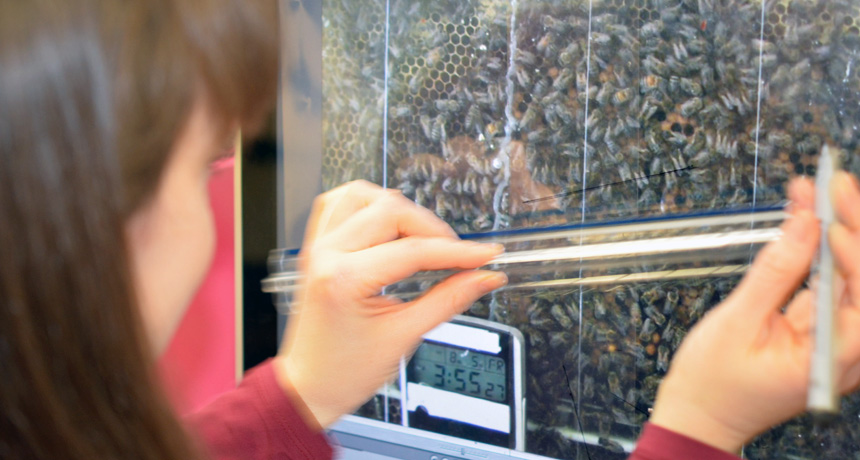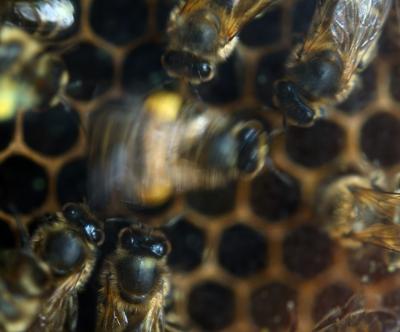Decoding bee dances
Biologists can eavesdrop on bees to learn which parts of the environment have the best bee grub

Behavioral ecologist Margaret Couvillon decodes the “sign language” of honeybees. How long they dance and how they angle their heads tell others where to find a good source of food.
Margaret Couvillon and Roger Schürch
Are people managing the landscape in an environmentally friendly way? For good clues, we may need to look no further than our local bees, says a biologist in England.
Honeybees perform a special “waggle” dance to tell hive-mates where to find the best flowers for nectar and pollen. Margaret Couvillon and her team spent two years decoding 5,484 dances performed by bees in three hives. Couvillon is a behavioral ecologist. She works at the University of Sussex in England.
“The bee waggles her body [while moving] in a straight line for a few seconds and stops. Then she circles back to the start and begins the dance over again,” explains Couvillon.
The length of time a honeybee waggles communicates how far away the food is. A one-second waggle means: “Fly for 750 meters” (nearly 2,500 feet). Direction is also provided in the dance. When bees waggle, they angle toward the food source, using their heads to point the way.
In nature, honeybees will dance in the darkness of their enclosed hive. So hive-mates won’t see this dance. Rather, they’ll hear the vibrating sound a dancing bee makes. They will even touch the dancer with their antenna to get a better sense of her vibrations and angle (and yes, the foraging bees are all female).
Bees that Couvillon’s team studied lived in hives built against a sheet of glass. That let the researchers watch the bees’ waggle-dances. The team’s findings appear in the June 2 Current Biology.

In their daily search for food, Couvillon’s bees covered about 100 square kilometres (62 square miles). By decoding the honeybees’ dances, the researchers learned that the bees did not find areas with lots of buildings very attractive.
Their favorite foraging places were in a nearby nature reserve where grass was left unmowed. The pollinators also liked farmland that had a lot of unmowed grass.
Bees prefer natural grasslands, Couvillon suspects, because they can use nectar and pollen from a range of flowering plants. The plants in natural grasslands bloom at different times of the year. That means there are flowers available for many months.
When a farm field is planted with just one type of crop, there is just one type of flower. And all those plants produce their flowers at once. That leaves little food for bees the rest of the year.
Bee dances could be used to help monitor how well people are protecting grasslands, says James Nieh. A biologist, he works at the University of California, San Diego.
One drawback to eavesdropping on bees: It takes a lot of time to collect and decode their dances, says Nieh, an expert in how bees communicate. “It would be helpful if researchers came up with an automatic waggle-dance video-analysis tool,” he says. “This would allow dance monitoring to be more widely used.”
In the past 20 years, European countries have spent more than 41 billion euros ($55 billion) to improve farmlands, increasing habitat that wildlife can use. Couvillon wanted to know if the money that was spent on fields around Sussex had made a difference.
It did help when it was used to compensate farmers for reducing the amount of land they planted with crops, she found. Then those growers could instead let more bee-friendly natural grasslands grow.
This is important information, because human societies have come to rely on bees. About one-third of the food people eat comes from plants that depend on bees to pollinate them.
Bees are not the only important insect pollinators. And some of those other pollinators could get a boost from any increase in a bee-friendly habitat. If bees like the landscape, Couvillon argues, those other pollinators likely will too.
Bee populations have dropped steeply over the past few years. Scientists suspect part of the reason is due to the insecticides sprayed to protect crops from plant-munching insects. Some of these chemicals may poison or confuse bees. But the new data suggest that bees also may be suffering from a critical loss of grasslands as people transform meadows and wildlands into cities and farms.
See dancing bees cast their votes on the best land-types and areas for finding food.
Credit: Margaret Couvillon and Roger Schürch
Power words
behavioral ecologist A scientist who studies animal behavior in a natural setting.
decode To convert a hidden or secret message into a language that can be understood.
forage To search for something, especially food.
insecticide A poison applied to kill insects.
nectar A sugary fluid secreted by plants, especially within flowers. It encourages pollination by insects and other animals. It is collected by bees to make into honey.
pollen Powdery grains released by the male parts of flowers that can fertilize the female tissue in other flowers. Pollinating insects, such as bees, often pick up pollen that will later be eaten.
pollinate The process of transporting male reproductive cells — pollen — to female parts of a flower. This allows fertilization, the first step in plant reproduction.







